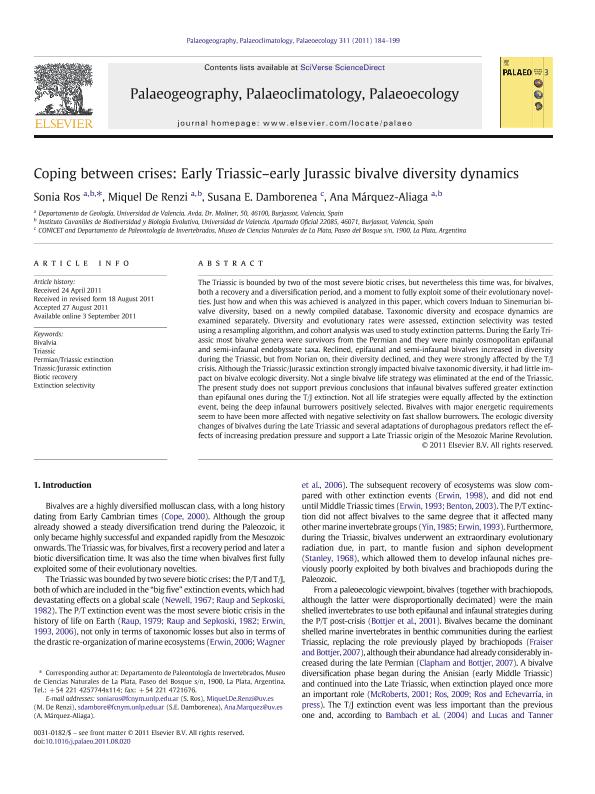Mostrar el registro sencillo del ítem
dc.contributor.author
Ros, Sonia
dc.contributor.author
De Renzi, Miquel
dc.contributor.author
Damborenea, Susana Ester

dc.contributor.author
Márquez Aliaga, Ana
dc.date.available
2019-08-09T20:06:28Z
dc.date.issued
2011-11
dc.identifier.citation
Ros, Sonia; De Renzi, Miquel; Damborenea, Susana Ester; Márquez Aliaga, Ana; Coping between crises: Early Triassic-early Jurassic bivalve diversity dynamics; Elsevier Science; Palaeogeography, Palaeoclimatology, Palaeoecology; 311; 3-4; 11-2011; 184-199
dc.identifier.issn
0031-0182
dc.identifier.uri
http://hdl.handle.net/11336/81358
dc.description.abstract
The Triassic is bounded by two of the most severe biotic crises, but nevertheless this time was, for bivalves, both a recovery and a diversification period, and a moment to fully exploit some of their evolutionary novelties. Just how and when this was achieved is analyzed in this paper, which covers Induan to Sinemurian bivalve diversity, based on a newly compiled database. Taxonomic diversity and ecospace dynamics are examined separately. Diversity and evolutionary rates were assessed, extinction selectivity was tested using a resampling algorithm, and cohort analysis was used to study extinction patterns. During the Early Triassic most bivalve genera were survivors from the Permian and they were mainly cosmopolitan epifaunal and semi-infaunal endobyssate taxa. Reclined, epifaunal and semi-infaunal bivalves increased in diversity during the Triassic, but from Norian on, their diversity declined, and they were strongly affected by the T/J crisis. Although the Triassic/Jurassic extinction strongly impacted bivalve taxonomic diversity, it had little impact on bivalve ecologic diversity. Not a single bivalve life strategy was eliminated at the end of the Triassic. The present study does not support previous conclusions that infaunal bivalves suffered greater extinction than epifaunal ones during the T/J extinction. Not all life strategies were equally affected by the extinction event, being the deep infaunal burrowers positively selected. Bivalves with major energetic requirements seem to have been more affected with negative selectivity on fast shallow burrowers. The ecologic diversity changes of bivalves during the Late Triassic and several adaptations of durophagous predators reflect the effects of increasing predation pressure and support a Late Triassic origin of the Mesozoic Marine Revolution.
dc.format
application/pdf
dc.language.iso
eng
dc.publisher
Elsevier Science

dc.rights
info:eu-repo/semantics/openAccess
dc.rights.uri
https://creativecommons.org/licenses/by-nc-sa/2.5/ar/
dc.subject
Biotic Recovery
dc.subject
Bivalvia
dc.subject
Extinction Selectivity
dc.subject
Permian/Triassic Extinction
dc.subject
Triassic
dc.subject
Triassic/Jurassic Extinction
dc.subject.classification
Paleontología

dc.subject.classification
Ciencias de la Tierra y relacionadas con el Medio Ambiente

dc.subject.classification
CIENCIAS NATURALES Y EXACTAS

dc.title
Coping between crises: Early Triassic-early Jurassic bivalve diversity dynamics
dc.type
info:eu-repo/semantics/article
dc.type
info:ar-repo/semantics/artículo
dc.type
info:eu-repo/semantics/publishedVersion
dc.date.updated
2019-07-17T17:47:12Z
dc.journal.volume
311
dc.journal.number
3-4
dc.journal.pagination
184-199
dc.journal.pais
Países Bajos

dc.journal.ciudad
Amsterdam
dc.description.fil
Fil: Ros, Sonia. Universidad de Valencia; España
dc.description.fil
Fil: De Renzi, Miquel. Universidad de Valencia; España
dc.description.fil
Fil: Damborenea, Susana Ester. Consejo Nacional de Investigaciones Científicas y Técnicas. Centro Científico Tecnológico Conicet - La Plata; Argentina. Universidad Nacional de La Plata. Facultad de Ciencias Naturales y Museo. Departamento de Paleontología Invertebrados; Argentina
dc.description.fil
Fil: Márquez Aliaga, Ana. Universidad de Valencia; España
dc.journal.title
Palaeogeography, Palaeoclimatology, Palaeoecology

dc.relation.alternativeid
info:eu-repo/semantics/altIdentifier/url/http://www.sciencedirect.com/science/article/pii/S0031018211004573
dc.relation.alternativeid
info:eu-repo/semantics/altIdentifier/doi/http://dx.doi.org/10.1016/j.palaeo.2011.08.020
Archivos asociados
